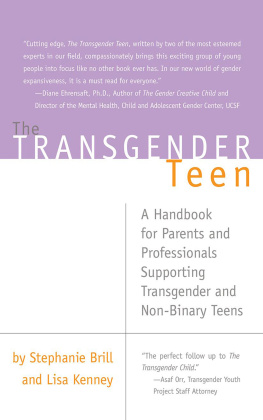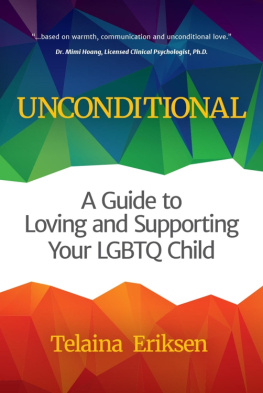THE
TRANSGENDER
CHILD
THE
TRANSGENDER
CHILD
A HANDBOOK FOR FAMILIES AND PROFESSIONALS
STEPHANIE BRILL
RACHEL PEPPER
REVISED AND UPDATED EDITION
Foreword by Diane Ehrensaft, phD
and Stephen Rosenthal, MD

Copyright 2022 by Stephanie Brill and Rachel Pepper.
All rights reserved. Except for brief passages quoted in newspaper, magazine, radio, television, or online reviews, no part of this book may be reproduced in any form or by any means, electronic or mechanical, including photocopying or recording, or by information storage or retrieval system, without permission in writing from the publisher.
Published in the United States by Cleis Press, an imprint of Start Midnight, LLC, 221 River Street, Ninth Floor, Hoboken, New Jersey 07030.
Printed in the United States
Cover design: Jennifer Do
Text design: Frank Wiedemann
First Edition.
10 9 8 7 6 5 4 3 2 1
Trade paper ISBN: 978-1-62778-324-8
E-book ISBN: 978-1-62778-537-2
TABLE OF CONTENTS
We dedicate this book to all the parents, professionals, and allies who support and affirm transgender and nonbinary children and teens. Together, we can help make the world a better place.
STEPHANIE AND RACHEL
And for Danny- your dazzling light has illuminated the way for so many.
STEPHANIE
And for my family, who support me in all that I do.
RACHEL
FOREWORD
IN 2008, when the first edition of The Transgender Child was published, Dr. Norman Spack completed his foreword with the following words: To date there has been no manual of care written specifically for the parents of the transgender child by people who have personal and professional experience. Now we finally have such a book. In the years that have transpired, the singular pediatric gender clinic in the country run by Dr. Spack has now blossomed to over fifty such programs. Dr. Spack has passed the baton to many of us, including the two of us writing this foreword, to carry out his groundbreaking work with gender expansive and transgender children and youth. Stephanie Brill and Rachel Pepper, the authors of The Transgender Child, have been instrumental in leading everyone in the work with all of these families.
For the first time Brill and Pepper gave parents and providers alike a groundbreaking, compassionate, and comprehensive GPS for offering understanding, love, and support to gender expansive and transgender young people. Now both authors are gifting us with an updated edition of their book, capturing all that has been learned and the changes that have occurred in the almost fifteen years since the first edition was released.
Over the past ten years a new model of care for the children identified in The Transgender Child has evolved: the gender affirmative model. The basic premise is that every individual is entitled to live in the gender that is most authentic to them. To that end, children are now increasingly recognized in their individualized gender journeys. Evidence-based research abounds to support them and their families along the path. Providers can now receive specialized training to ensure that sensitive and gender-affirming interdisciplinary care is available to children and their families outlined in evidence-based clinical practice guidelines and standards of care. Worldwide, organizations have blossomed offering education, community, and advocacy to the ever-growing number of families supporting their children in their authentic gender. As the gender affirmative model has become the standard of care for transgender children and their families, we have come to recognize the wonderful intricacies of childrens gender variations and the metaphorical roses with thorns that each family encounters as they traverse the pathways of supporting their children in a world that does not always support them.
While this model of care is evidence-based, there are some who are disturbed by gender-affirmative practices and by the growing number of families supporting their children in their authentic gender selves. Rest assured, every major professional organizations position on the care and support of transgender and gender expansive children and teens is consistent and based in science. There is no doubt in our minds that parents who support their kids and help them access medically necessary and essential gender-affirming health care, as needed on a case-by-case basis in collaboration with experienced and well trained medical and mental health professionals, are doing what is best for their children.
The Transgender Child, in its revised edition, comes at a timely point in history when parents and providers need a trusted, reliable voice to guide them through a deeply personal issue that has become mired in politics. More than ever we need Brill and Peppers updated GPS to guide families and providers alike in supporting each and every child to be themselves.
As two of the founders of the university-community partnered Child and Adolescent Gender Center at the University of California San Francisco, we, the director of mental health and medical director respectively, now invite you to engage in the pages of the revised edition of The Transgender Child.
Diane Ehrensaft, PhD, director of mental health, Child and Adolescent Gender Center, UCSF
Stephen Rosenthal, MD, medical director, Child and Adolescent Gender Center, UCSF
INTRODUCTION
MOM, IVE ALREADY TOLD YOU, Im a girl, so stop saying HE!
Alejandro had tried to tell his parents, from the time that he could barely talk, that he was really a girl. He would toddle into his older sisters closet to put on her dresses. He would wrap his hair in scarves and towels. He was always in his moms makeup and shoes. At 3, he regularly cried himself to sleep asking God why he made a mistake. By 4, he was still repeating the above phrase, IVE ALREADY TOLD YOU, Im a girl, so stop saying HE! when addressed as a boy, much to the confusion of his parents. By 5, he spoke openly of wanting to kill himself, of not belonging in this world, of wanting to disappear. His parents initially thought it was just a phase, something every child goes through at some point. But when it didnt end, the only explanation they could think of was that he was probably gay. They reached out for help, concerned for their child. Their pediatrician recommended a therapist, and that therapist has since suggested that Alejandro may be transgender.
It took Ninas parents a number of years to realize that Nina always answered the question Are you a boy or a girl? the same way. She would say, I am Nina. Initially, people thought her response was cute, but as she got older, they started to feel that she was playing games with them by not answering the question. Furthermore, her parents started to get mad at her for being rude. Nina tried to explain that she didnt feel like a girl or a boy. Why did it matterwhy couldnt she just be herself? Her parents firmly told her she was a girl, thinking it might settle the matter. Unfortunately, it was not so easy for Nina. Every time she had to choose a gender, as when lining up by boys and girls in class, she felt anguished, and it was hard for her to follow instructions. Eventually, an insightful teacher made the connection when Nina started to wet her pants and stay in the coatroom right before lineup time. A child psychiatrist has brought up the idea that Nina may feel nonbinary, or agender, or be gender-fluid.
Do these stories ring a bell? Throughout history, there have been children who challenged traditional gender categories. But parenting practices and societal expectations have often caused those children to hide their identities from others and sometimes even from themselves.
Next page






